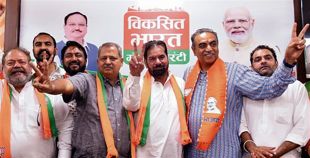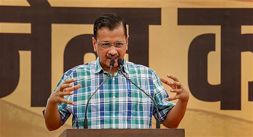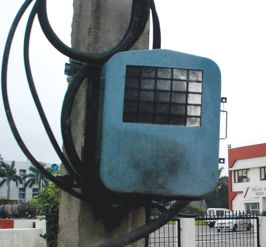
Photo for representational purpose only. iStock
Vibha Sharma
Chandigarh, September 28
With just two days to go before the four-month sojourn of the Southwest Monsoon in India officially ends on September 30, the current rain deficiency stands at six per cent.
This year, the behavioural pattern of the monsoon has underlined the concerns of environmentalists regarding the visible impact of global warming and climate change on its pattern. Not only did the 2023 season spring more surprises than past years, the delay in retreat for the 13th consecutive year also underlined the need for back-up plans for India’s crucial agriculture sector.
The monsoon 2023 is a stark reminder of the climate’s unpredictability and its deep impact on India’s agriculture and economy, say experts.
Monsoon retreat
Monsoon started retreating on September 25— eight days behind its “normal” withdrawal date of September 17. The IMD says conditions are becoming favourable for its further withdrawal from some more parts of northwest and adjoining west-central India in the next 2-3 days
For now, the line of retreat continues to pass through Nokhra, Jodhpur and Barmer, it adds
The changes in the departure dates again raised concerns over the monsoon pattern in India where more than 50 % of the agricultural tracts are dependent upon seasonal rains. While delayed retreat posed challenges for agricultural scheduling and production in the northwest, extra rains brought relief to rain-deficit parts.
“The withdrawal typically marks the start of the Rabi season in the northwest. Changes in the timeline may impact planning and production. Timely arrival and retreat play a crucial role in both Kharif and Rabi season,” experts say.
Monsoon statistics
“Normally” monsoon enters Kerala by June 1, covers the entire country by July 8 and starts retreating from northwest around September 17.
The retreat gets completed by October 15, but the season officially concludes on September 30.
So far, till date (September 28) the country is 6% short of expected rain in the season.
The highest shortfall of 18% is in the east and northeast, followed by 9 % in the south peninsula.
Central India has no deficiency, while northwest is 1% in the excess as on date.
In the IMD parlance, 90 to 95% of Long Period Average (LPA) is categorised as “below normal”, less than 90% “deficient” and 96 to 104% of LPA: “normal”. In those terms, the rains so far are bordering around ‘near-normal’.
Monsoon, an important contributor to India’s economy
More than 50% of the country’s agricultural lands and 40% of production rely on seasonal rains.
More than half of its population (some reports peg the figure at two-third) depends on the agriculture sector.
The point is that monsoon rains are keys to agriculture, feeding aquifers, rivers, replenishing groundwater and dams and the power sector—overall, the general health and happiness of the country and its people.
‘Rogue’ monsoon
India is a huge country and differences in rain distribution are an expected feature. But this year’s monsoon pattern has proved that the threat of climate change is not something in the future but real-time.
While hills of the North bore the brunt, some other parts that witnessed floods in the first half were left wanting in August.
Rains in August were the lowest in 122 years since 1901 across central India and the south peninsular region, making it one of the deficient monsoon months in history, according to the IMD.
August recorded 162.7 mm compared to 254.9 mm actual.
Average maximum and mean temperatures also remained the highest since 1901.
The northward movement of monsoon trough, and its interaction with WDs, resulted in unprecedented rains in Himachal Pradesh and Uttarakhand, leading to the death of several persons in landslides apart from dilapidating damage to infrastructure.
Experts say that delayed retreat led to both positives as well as negatives.
While some extra rains helped reduce the deficit of an unusually dry August, the prolonged stay may result in changes in the agricultural calendar.
Monsoon prediction
In its pre-monsoon briefing, the IMD had predicted a normal monsoon for India, though on the lower side of the normal. In those terms, the prediction is not exactly off the mark.
It also cautioned that El Nino—the warming of waters in the Pacific Ocean near South America—might influence the latter half.
But was the IMD able to forewarn excesses and deficits is the bigger question in mind the climate change situation.
This year, India experienced a rainfall deficit in June but excessive precipitation in July due to consecutive WDs over northwest and a favourable phase of the Madden-Julian Oscillation, known for increasing convection in the Bay of Bengal and the Arabian Sea.
August 2023 marked the driest month since 1901 and the hottest ever recorded in India due to the strengthening of El Nino conditions.
September, however, brought excess rain due to multiple low-pressure systems and the positive phase of MJO.
In the beginning of the season, the IMD had predicted 96% rains of the LPA in the country, along with an impact of El Nino in the latter part of the June-September season.
For the northwest, it had predicted “normal to below normal rains”
The region, however, received excess rainfall, leading to flash floods, landslides and damage to infrastructure in Punjab, Haryana, Delhi and Himachal Pradesh in July as well as August.
The fact is Monoson 2023 has put a question mark on IMD’s prediction capabilities.
Apart from lamenting “inadequate study of monsoon pattern”, experts also find fault in models IMD uses “which can predict light or moderate rain but only give an indication that heavy or very heavy rainfall will happen in certain areas.”
Join Whatsapp Channel of The Tribune for latest updates.




























